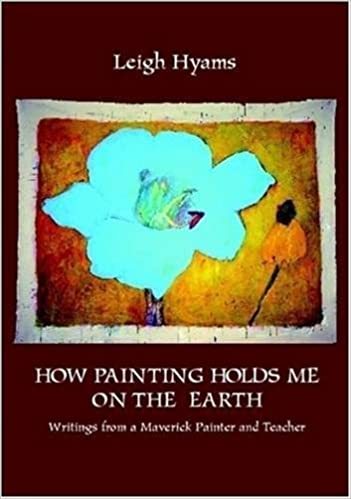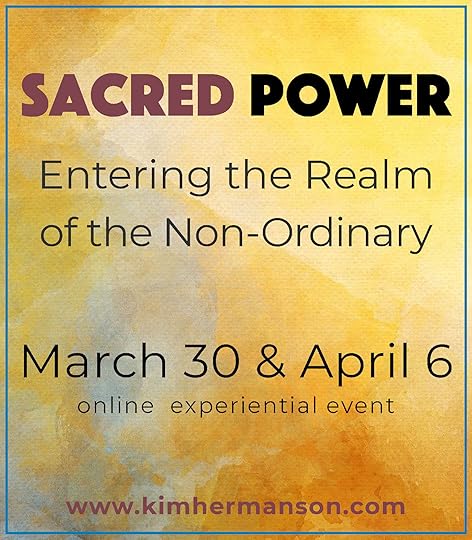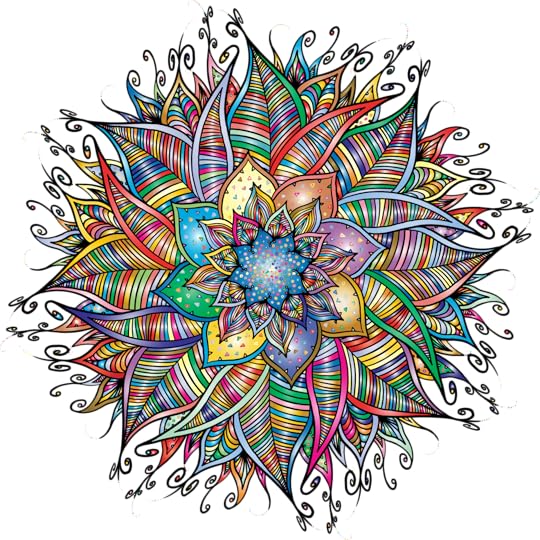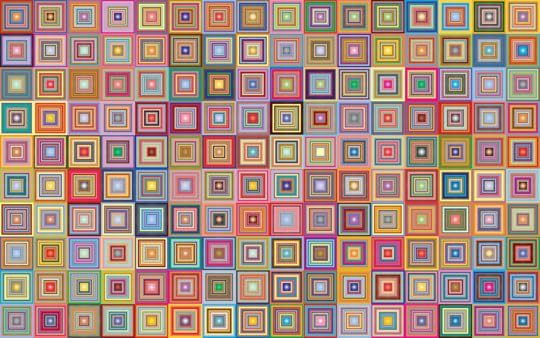Kim Hermanson's Blog, page 26
April 10, 2021
A deeper human language
 When I work with a client’s deep inner images, I draw on the same visual language that artists work with, and so I find visual art, especially drawing, fascinating. I tell my students and workshop participants that we need to shift “how we are looking” to understand these potent inner images and allow them to take us into the vibrational energies of the intelligent field. It’s been hard for me to describe this way of looking, so I’ve looked to artists for help.
When I work with a client’s deep inner images, I draw on the same visual language that artists work with, and so I find visual art, especially drawing, fascinating. I tell my students and workshop participants that we need to shift “how we are looking” to understand these potent inner images and allow them to take us into the vibrational energies of the intelligent field. It’s been hard for me to describe this way of looking, so I’ve looked to artists for help.
On that note, here are some excerpts from Leigh Hyams’ book, How painting holds me on the earth.
This sentence (describing what she does when she paints a landscape) is especially helpful :
Though a particular landscape is involved, I’m not ‘describing’ it. It’s a combination, perhaps, of experiencing, digesting, inhaling, even embodying it, and then speaking about it in paint.
Some other excerpts:
A painting is a portal, sometimes a seducer, which unlocks, opens, and leads the perceptive viewer into an un-nameable personal experience beyond words. A painting either has an “essence” or it does not. (page 15)
We have to trust the creative process wherever it leads us, knowing that with each drawing or painting we make with our whole hearts, our understanding of the richness and profundity of visual language–non-verbal language–will deepen. (page 32)
Don’t “read” a painting like a book, don’t “de-code” the images presented and tell the group what they remind you of. Explanations or stories in words may be interesting in themselves but they are irrelevant in a critique. We are only concerned with the actual painting itself, the visual language in which it is speaking–how the artist I handling the relationship of color, line, and space, its movement on the two-dimensional group, its rhythms, texture, line quality, and how they relate to the expressiveness of the images being painted. (page 89)
Realize that you are learning a new language. (page 90)
We humans have three ways of knowing: 1) rational, logical. 2) through the senses, and 3) a non-verbal aesthetic language that some lucky people have been able to learn through art-making. This deep way of knowing is neglected in our culture, but… this language is how we connect with Spirit and with the wisdom that lies beyond our thinking mind. Artists know this language. They know how to FEEL the truth of something.
February 27, 2021
Sacred Power: Entering the Realm of the Non-Ordinary
 I used to think the mistakes I’d made had ruined my life.
I used to think the mistakes I’d made had ruined my life.
I walked away when a major publisher wanted to publish Getting Messy in a different format. I lost an inheritance by investing in questionable stock purchases. I let a special person get away. I failed to plan ahead. And so on.
But by working with the intelligent field, I’ve learned that no foolish decision or misguided action can ever alter my destiny or potential.
We humans have access to incredible power.
I hope you will join me for my next online experiential seminar. It’s time to honor the wisdom that’s nudging you.
SACRED POWER: ENTERING THE REALM OF THE NON-ORDINARYTuesdays March 30th & April 6th 11 am – 1 pm PDT
EARLY BIRD rate: $59 until March 14th
includes recordings, handouts & the opportunity to work w/KimNote: This course will be on Zoom, you can participate from anywhere in the world. If you can’t attend live you can still register to receive the recordings.
· · ·No matter how much we push, intend and effort, we don’t have all the answers that we seek.
But Something else does.
We can set goals, make commitments, get action partners, read self-help books and push ourselves to achieve what we want. Or… we can align with Something greater.
I recommend you do the latter.
When one has been moved by Spirit, one never forgets it. We never forget experiences of touching Something greater than ourselves.
There is an energetic place where you are hooked up, aligned with your Highest Self, and connected to your own deep knowing. A place where Spiritual resources can flow through you.
In this experiential seminar, we’ll open a field of potent Source energies and powerful intelligence that is not of this world. As you anchor in this vibrational field, you’ll discover new spaces of possibility and resources, as well as a flow, grace, ease, strength, and clarity.
When we’re in the right energy, things happen. We humans have access to incredible resources.
rest in deep truthdiscover your innate strengthstep into the work that’s claimed youreconnect with Spirit & inner guidanceexperience the ease, grace, & beauty of hooking up to your own deep knowingOnly this realm knows what you need for your whole life to change. Please join us.
“Kim’s work is pioneering.” ~ Mihaly Csikszentmihalyi, New York Times bestselling author of Flow: The Psychology of Optimal Experience
February 23, 2021
Uncovering the Subconscious Image that’s Guiding Your Actions
 Each of us has a primary metaphoric image that gives life to and feeds our passions and gifts. These primary images usually come from childhood, and they’re often associated with that natural world.
Each of us has a primary metaphoric image that gives life to and feeds our passions and gifts. These primary images usually come from childhood, and they’re often associated with that natural world.
My metaphoric image is of my father and grandfather planting in their farm fields. One of my students who grew up in Mexico holds the image of festive Mexican markets in her heart—colorful, festive, and filled with lively people. A friend of mine’s metaphoric image is her family’s “ramshackle” summerhouse that she liked so much better than their ‘respectable’ house in the city.
Organizations, institutions, families, social networks, and entire countries also have metaphoric images that provide guidance and a sense of meaning for their members. One could argue that the image that lies at the root of the United States is a melting pot. Others may argue that the US’s primary image is of a Revolutionary War soldier fighting for religious freedom and liberty.
When we’re connected to the metaphoric image that lies under the surface, we experience a sense of meaning. Our experiences aren’t random—they’re ‘connected’ to something. We have a way to make decisions. We feel a sense of purpose. Conflicts occur when other people hold different (conflicting) guiding images.
In our culture, metaphor is often viewed as either a slick tool of language that poets use, or something that’s “make believe.” “That’s just a metaphor,” we say. But if we really understood how powerful metaphoric is in guiding and informing our actions, we would value it in a much different way.
What image is guiding you… or your organization, family, or project?
 Each of us has a primary metaphoric image that gives life to and feeds our passions and gifts. These primary images usually come from childhood, and they’re often associated with that natural world.
Each of us has a primary metaphoric image that gives life to and feeds our passions and gifts. These primary images usually come from childhood, and they’re often associated with that natural world.
My metaphoric image is of my father and grandfather planting in their farm fields. One of my students who grew up in Mexico holds the image of festive Mexican markets in her heart—colorful, festive, and filled with lively people. A friend of mine’s metaphoric image is her family’s “ramshackle” summerhouse that she liked so much better than their ‘respectable’ house in the city.
Organizations, institutions, families, social networks, and entire countries also have metaphoric images that provide guidance and a sense of meaning for their members. One could argue that the image that lies at the root of the United States is a melting pot. Others may argue that the US’s primary image is of a Revolutionary War soldier fighting for religious freedom and liberty.
When we’re connected to the metaphoric image that lies under the surface, we experience a sense of meaning. Our experiences aren’t random—they’re ‘connected’ to something. We have a way to make decisions. We feel a sense of purpose. Conflicts occur when other people hold different (conflicting) guiding images.
In our culture, metaphor is often viewed as either a slick tool of language that poets use, or something that’s “make believe.” “That’s just a metaphor,” we say. But if we really understood how powerful metaphoric is in guiding and informing our actions, we would value it in a much different way.
What metaphors are guiding you… or your organization, family, or project?
 Each of us has a primary metaphoric image that gives life to and feeds our passions and gifts. These primary images usually come from childhood, and they’re often associated with that natural world.
Each of us has a primary metaphoric image that gives life to and feeds our passions and gifts. These primary images usually come from childhood, and they’re often associated with that natural world.
My metaphoric image is of my father and grandfather planting in their farm fields. One of my students who grew up in Mexico holds the image of festive Mexican markets in her heart—colorful, festive, and filled with lively people. A friend of mine’s metaphoric image is her family’s “ramshackle” summerhouse that she liked so much better than their ‘respectable’ house in the city.
But organizations, institutions, families, social networks, and entire countries also have metaphoric images that provide guidance and a sense of meaning for their members. One could argue that the image that lies at the root of the United States is a melting pot. Others may argue that the US’s primary image is of a Revolutionary War soldier fighting for religious freedom and liberty.
When we’re connected to the metaphoric image that lies under the surface, we experience a sense of meaning. Our experiences aren’t random—they’re ‘connected’ to something. We have a way to make decisions. We feel a sense of purpose.
Of course, conflicts occur when other people hold different (conflicting) guiding images.
In our culture, metaphor is often viewed as either a slick tool of language that poets use, or something that’s “make believe.” “That’s just a metaphor,” we say.
But if we really understood how powerful metaphoric is in guiding and informing our actions, we would value it in a much different way.
February 22, 2021
Creating Space for Spirit to Speak
 I have studied learning and creativity for thirty years.
I have studied learning and creativity for thirty years.
We humans think from our egos and we create from our egos. It’s all about “me me me.” Even people who are social activists often come from a place of “what can I do? I need to do more. I need to help.”
Because of this orientation, we completely miss that there’s a whole other intelligence available to us that wants to work with us. But in order for it to work with us, we have to let go of our egos—the driven part of ourselves. The part of ourselves that wants to please, produce, succeed, and “achieve our potential.”
Yes, even the part of us that’s motivated to help others and to serve. The ego likes to mask itself as doing good things and serving others. It has an outsized view of its own importance.
To let Divine Intelligence work through us, we have to let go of our desire to help, drop the incessant thinking, and be in “no mind.”
When the thinking mind gets out of the way, divine Intelligence has room to work with us.
This IS a paradigm shift; it’s a shift of our whole motivation and orientation in life. And it’s impossible for many people to make because we’ve all been trained to achieve and produce.
We simply need to learn to trust the quiet, still part of ourselves.
We Push When We Really Need to Deepen
 I have studied learning and creativity for thirty years.
I have studied learning and creativity for thirty years.
We humans think from our egos and we create from our egos. It’s all about “me me me.” Even people who are social activists often come from a place of “what can I do? I need to do more. I need to help.”
Because of this orientation, we completely miss that there’s a whole other intelligence available to us that wants to work with us. But in order for it to work with us, we have to let go of our egos—the driven part of ourselves. The part of ourselves that wants to please, produce, succeed, and “achieve our potential.”
Yes, even the part of us that’s motivated to help others and to serve. The ego likes to mask itself as doing good things and serving others. It has an outsized view of its own importance.
To let Divine Intelligence work through us, we have to let go of our desire to help, drop the incessant thinking, and be in “no mind.”
When the thinking mind gets out of the way, divine Intelligence has room to work with us.
This IS a paradigm shift; it’s a shift of our whole motivation and orientation in life. And it’s impossible for many people to make because we’ve all been trained to achieve and produce. We simply haven’t learned to trust the quiet, still part of ourselves.
Although it’s contradictory to how we think, we need to become empty to experience abundance.
February 15, 2021
Metaphor, Martin Foss, and the creative process

The present is not a phase in time. It is the tension by which past and future are metaphorically united and overcome. ~ Martin Foss
Ten years after I completed the Ph.D., I was speaking to the president of a graduate school about teaching courses for his doctoral students in Depth Psychology. I didn’t have any predefined ideas of what I wanted to teach at this school, but I presumed we would discuss something related to adult learning. In the interview, he looked at me quizzically and then said, “Instead of trying to fit you into our program and have you teach something on our roster, why don’t you tell me what you’d like to teach.” It was a prophetic moment and a prophetic question because to my great surprise, Spirit spoke through me and said I would be teaching a course on metaphor.
I was stunned. I didn’t know anything about metaphor as an academic subject, nor how it related to psychology. But the president of the school responded back promptly as if nothing out of the ordinary had just happened. “Great! We’ll call it the Psychology of Metaphor.”
I walked out of his office not knowing what I was doing or what was going on. This course for Ph.D. students was scheduled to start in two months.
The poet William Blake suggested that if we follow the “golden string” we will be led to Heaven’s Gate, and golden strings started showing up for me almost immediately. Soon after the conversation, antiquated out-of-print books about the psychology of metaphor miraculously started appearing at the library where I do my research. While sitting at a table in the huge reading room, I would glance up from what I was reading, and lying there in front of me would be yet another peculiar book about metaphor, waiting patiently for me to notice it. Foundational research materials continued to show up for me in this mysterious way.
The most influential of these books was Martin Foss’s Symbol and Metaphor in Human Experience. Published in 1949, it looked old-fashioned and obsolete, but something drew me to it.
His writing spoke to me on a deep level. It awakened an understanding of metaphor and the creative process as the central elements of human life. For Foss, metaphor is not merely a tool for our rational minds to play with: it is life itself.
Foss defines metaphor as the ongoing creative process that continually flows through everyday life:
…a process of tension, energy, and creative destruction; one that begins with symbols but transcends and transforms all symbolic fixations and reductions…metaphors break up instead of fixing, keep us on the move instead of letting us settle down…[metaphor] widens, transcends, overcomes, gives birth to the new. Metaphor, compared to the clear, exact, and useful symbol, seemed unclear, complex, and useless—even as a superfluous luxury in the economy of the human mind. It was regarded as an ornamental addition. But what soon came to puzzle thinking men was how a supposed ornament could exert so dynamic a power in myth and artistic creation.
Foss’s view of metaphor is aligned with its ancient roots and meanings. While the word symbol means linking together two dissimilar things (coming from the Greek roots syn which means “together” and ballein, which means “to throw”), the word metaphor means a carrying beyond. Metaphor comes from the Greek roots meta (“across” or “beyond”) and pherein (to “transfer” or “change”).
Unlike the symbol, metaphor is not just a link to something new; metaphor takes us somewhere by changing form. With metaphor, things shift and move—our deep, inner creative process is shamanic territory.
Metaphor operates below our conscious minds, so it’s not something we can thoroughly understand through a rational thinking process. It’s not quite “of this world,” it’s “in-between” the realms, and trying to define it is slippery. In fact, in his book, Death, Sacrifice, and Tragedy, Foss goes so far as to say:
“[Metaphor] is the secret of all life. It is the innermost secret of the life of God himself.”
Upon doing a little research, I discovered that at the time Symbol and Metaphor was published in 1949, it was highly acclaimed and prompted some scholars to regard Foss as a greater philosopher than Martin Heidegger (see Armour & Trott’s book, The Faces of Reason: An Essay on Philosophy and Culture in English Canada.) But a few short years later, Foss and his work were largely forgotten. In 1956, the American Scholar listed Symbol and Metaphor in Human Experience as one of the most important and neglected books of the twentieth century.
In our culture, there is a scarcity of consciousness about how process happens in our lives and in the world. Our rational minds view life and other people as largely static, even unchanging, in many ways. Foss’s books—which also include Death, Sacrifice and Tragedy and Logic and Existence—are inspirational and broad in scope and they deserve to be more widely known.
Picasso famously said that every act of creation begins with an act of destruction. A similar notion comes from the process philosophy of Teilhard de Chardin and the Kabbalists. The Kabbalists held that the process of both God’s and man’s creativity is predicated upon a dialectic of destruction and rebirth, in which old configurations of thought and being are consistently torn asunder to make way for new conceptions and forms of life. Such breakage can occur in a person’s life and provide him or her with sufficient chaos to be personally reborn.
In Death, Sacrifice and Tragedy, Foss calls this dialectic of destruction and creative rebirth a “sacrament”:
Life in its core is a perpetual conversion from a lower sphere to a higher one, destroying the lower for the sake of realizing the higher, and this creative destruction, the sacrificial action, conveys to life its essential character, which is sacramental.
Many of you have probably experienced “building” stages in your life. Periods of time when you invested your heart, sweat, tears and years, into developing something—a family, a business, a work of art, a career. And then at some point later, it all crumbles—your spouse leaves and the kids move out, your career no longer inspires you, the band you’ve spent years developing dissolves, the business goes belly up. Foss calls this profound loss of something we’ve invested our life energy in… the sacrificial nature of the creative.
The process of regeneration—or what Foss calls creative destruction—is how a culture stays vibrant. It’s also how we humans stay vibrant.
January 23, 2021
Being Centered In Your Gift
 Don’t write a book to help people.
Don’t write a book to help people.
Don’t teach a class because you think people need to know something.
Don’t become a therapist or coach because you want to help or heal others.
If your focus is on other people and what you think they need… you’re not centered in your gift.
Your focus needs to be on your connection with the Deep Creative, not on other people.
January 7, 2021
Showing Up to Spirit As an Equal
 In doorway sessions, clients discover their unique relationship with Spirit–the unique way that Spirit wants to work with them.
In doorway sessions, clients discover their unique relationship with Spirit–the unique way that Spirit wants to work with them.
Because our ultimate assignment is to become Spirit’s dance partner.But in order to be that dance partner, we have to be our full selves.
We have to show up as an equal.
We don’t just snap our fingers to become Spirit’s dance partner. It takes spiritual growth and a shifting of our energy. I’ve worked with hundreds of clients over the years and what shows up from the intelligent field is always the Source vibration that they most need to bring them into their fullness. Here are the most common:
GOOD FORM: We need to develop a strong, sturdy sense of self with good boundaries. Good form is how we hold yourself in the world. When we have GOOD FORM we don’t unravel with unforeseen events or circumstances. A client was going through a scary divorce with a domineering husband. She needed to learn how to hold GOOD FORM in the meetings with her husband and their lawyers.
Where do you need better form?
GOOD SENSE OF SELF, CLARITY, DEFINITION: A sense of knowing who we are in this world. Women who have spent many years as mothers are often working these energies. Clarity and definition can start with simple things: “I like this, I don’t like that” “this is OK with me, this is not OK with me” “I will go in this direction and not in that direction.”Many people come to me because they want to launch a business or creative work that represents what’s true about them. This requires a GOOD SENSE OF SELF, CLARITY and DEFINITION.
Where do you need to set a boundary or be more clear?
WHOLENESS: Wholeness is owning the lost pieces of our lives. For myself, I spent much of my adult life dismissing my mystical and visionary experiences. I was too scared to look at this part of my life and too timid to acknowledge that I was being called to work on Spirit’s behalf. I’ve also spent years developing my creative self, but dismissing the businesswoman and academic parts of myself. WHOLENESS required me to own these lost and dismissed parts.
What parts of your life or what inner passions do you need to own and embrace?
RIGHT SIZE:Many of us, especially women, have been too small in this world, while some of us think of ourselves as too big. Being arrogant or having a big ego are examples of being too big, but being too big also happens when we have an outsized view of what we believe we can accomplish. For example, sometimes I work with therapists or counselors who have way too many clients. They need to realize they can’t help that many people–they need to be smaller.
Have you been hiding, do you need to be bigger? Or… for right now, does it feel right to pull back and not be so big?
Although the Source vibrations of STURDY SENSE OF SELF, GOOD FORM, CLARITY, DEFINITION, WHOLENESS, and RIGHT SIZE are the most common, there are numerous other energies that may arrive, such as: LIGHTNESS, EXPANSIVENESS, STILLNESS, FREEDOM, FLOW, ROOTEDNESS, STRENGTH, DEPTH, an INNER FOCUS, GENTLENESS, REST, CREATIVE FIRE, EROTIC and so on.
Many of my clients don’t tend to view themselves as equal to Spirit. And of course, when we’re hurting, we may need to curl up in the womb of the Loving Mother for awhile. But the ultimate goal of your life is not to be a passive receiver. It’s to be a sacred co-conspirator.
Sometimes, a person’s Spirit teacher, guide, or power animal shows up. But in my work, these spirit teachers only come when the client is ready to meet them as an equal.
They come to meet you in your full strength… so you can meet them in theirs.
That’s when brilliance happens.



